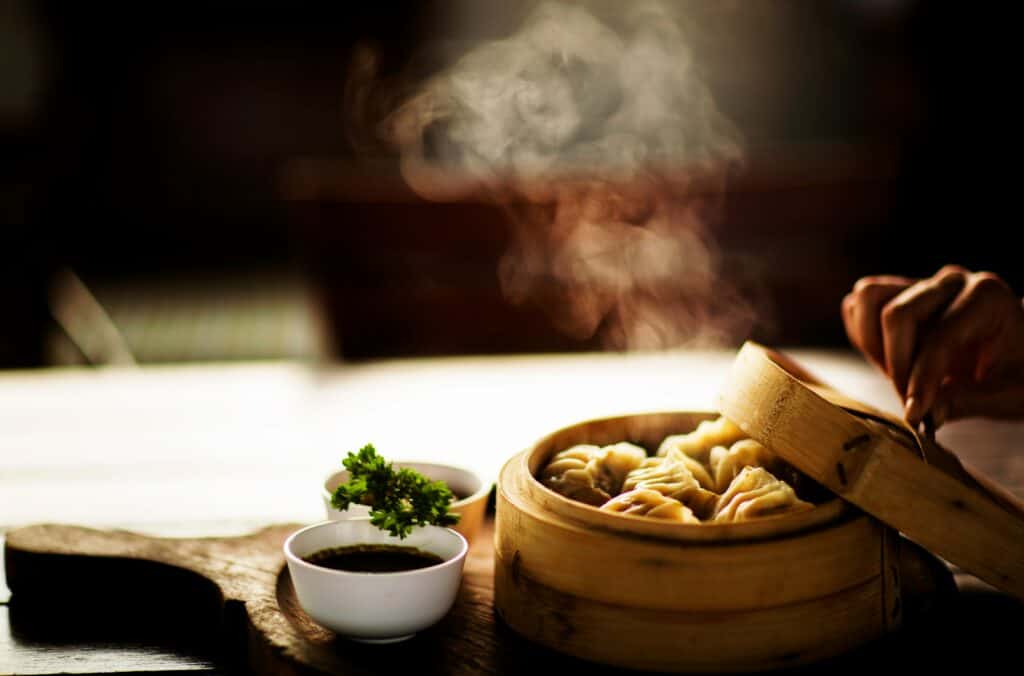Los dumplings son una parte muy apreciada de la cocina asiática, y cada cultura cuenta con variedades únicas que difieren en ingredientes, preparación y sabor. En este artículo compararemos Buuz (albóndigas mongolas), Xiao Long Bao (albóndigas de sopa chinas) y otras albóndigas populares asiáticas. para destacar sus diferencias y similitudes.
Introducción
Los dumplings son parte esencial de muchas cocinas asiáticas, cada una con su propio estilo y tradición. Desde los sustanciosos Buuz de Mongolia a la delicada Xiao Long Bao de ChinaEstos dumplings reflejan los sabores regionales, las técnicas culinarias y el patrimonio cultural.

Este artículo compara el Buuz, el Xiao Long Bao y otros conocidos dumplings de Asia, ayudándole a entender sus diferencias y a apreciar sus cualidades únicas.
Buuz: El Dumpling Mongol
Origen e importancia cultural
Buuz (pronunciado booz) es un Dumpling mongol al vaporcomúnmente consumido durante el Año Nuevo Lunar Mongol (Tsagaan Sar). Son un alimento básico en los hogares mongoles y suelen tomarse con té o bebidas lácteas fermentadas.
Ingredientes clave y preparación
- Masa: A base de harina y agua.
- Relleno: Carne picada de cordero o ternera, sazonada con sal, pimienta negra y cebolla.
- Método de cocción: Se cuecen al vapor en una olla grande hasta que estén totalmente cocidos.
Manera tradicional de servir
El buuz se disfruta mejor caliente, a menudo acompañado de leche de yegua fermentada (airag) o té con leche salada.
Xiao Long Bao: La albóndiga de sopa china
Origen e historia
El Xiao Long Bao tiene su origen en la Región china de Jiangnanespecialmente Shanghái. Es famosa por su piel fina y delicada e interior relleno de sopa.
Características únicas
- Masa: Fina, elástica y ligeramente translúcida.
- Relleno: Carne picada de cerdo, caldo gelatinizado, jengibre y salsa de soja.
- Método de cocción: Al vapor en cestas de bambú.
Cómo comer Xiao Long Bao
Para disfrutar adecuadamente del Xiao Long Bao:
- Cógelo con cuidado con palillos.
- Colócalo en una cuchara, haga un pequeño agujero y beba a sorbos el caldo.
- Inmersión en vinagre negro con jengibrey luego comer el resto.
Otros dumplings asiáticos
Las diferentes culturas asiáticas tienen sus propias versiones de dumplings, cada una con una forma, sabor y método de cocción distintos. He aquí algunas de las más notables:
- Jiaozi chino (albóndigas hervidas o fritas con rellenos de carne y verduras)
- Gyoza japonesa (similar al Jiaozi pero con un envoltorio más fino y condimento de ajo)
- Mandu coreano (albóndigas al vapor, hervidas o fritas con carne de cerdo, tofu y verduras)
- Momo tibetano (albóndigas al vapor con rellenos de carne o vegetarianos, a menudo picantes)
- Vietnamita Bánh Bột Lọc (albóndigas de tapioca con gambas y cerdo)
Buuz vs. Xiao Long Bao: Principales diferencias
| Característica | Buuz | Xiao Long Bao |
|---|---|---|
| Masa | Más espeso, a base de harina | Fino, elástico, translúcido |
| Relleno | Carne de cordero o ternera, poco condimentada | Cerdo con caldo gelatinizado |
| Método de cocción | Al vapor | Al vapor |
| Textura | Fuerte y firme | Suave y jugoso con sopa en su interior |
| Sabor | Sabroso, ligeramente a caza | Rico y lleno de umami |
¿Cómo se comparan otros dumplings?
- Gyoza frente a Jiaozi: La Gyoza es más fina, crujiente y con más sabor a ajo que la Jiaozi.
- Mandu contra Momo: Mandu es más suave y suave, mientras que Momo es más picante.
- Bánh Bột Lọc vs. Xiao Long Bao: El Bánh Bột Lọc tiene una textura masticable y translúcida, mientras que el Xiao Long Bao es tierno y caldoso.
Comparación de sabor y textura
Cada bola de masa tiene una textura única:
- Buuz: Denso, masticable, carnoso.
- Xiao Long Bao: Suave, delicado, jugoso.
- Gyoza/Mandu: Crujientes, masticables o blandas según el estilo de cocción.
Salsas y acompañamientos
- Buuz: Consumido solo o con bebidas lácteas.
- Xiao Long Bao: Sumergido en vinagre negro con jengibre.
- Otras albóndigas: Salsa de soja, aceite de chile o salsas a base de ajo.
Comparación nutricional
- Buuz: Mayor contenido en proteínas y grasas gracias al cordero.
- Xiao Long Bao: Mayor contenido en carbohidratos debido al contenido de sopa.
- Gyoza/Jiaozi: Proteínas, grasas y carbohidratos equilibrados.
¿Qué bola de masa le conviene más?
- Para los amantes de la carne: Buuz.
- Para los amantes de la sopa: Xiao Long Bao.
- Para una textura crujiente: Gyoza o Mandu frito.
Conclusión
Buuz, Xiao Long Bao y otros dumplings representan la rica diversidad culinaria de Asia. Tanto si prefiere el carnoso y sustancioso Buuz como el delicado Xiao Long Bao, lleno de caldo, u otra variedad, explorar los dumplings es un delicioso viaje a través de diferentes culturas.
¿Cuál es tu dumpling favorito? ¡Háganoslo saber y pruebe unos sabrosos dumplings en su viaje a Mongolia!